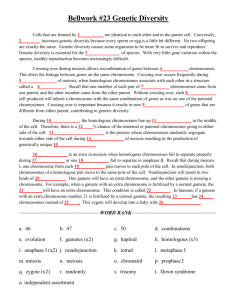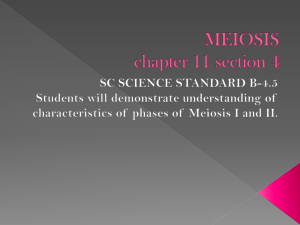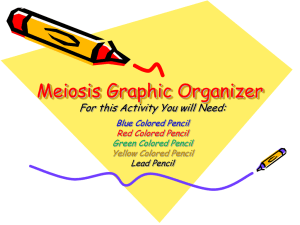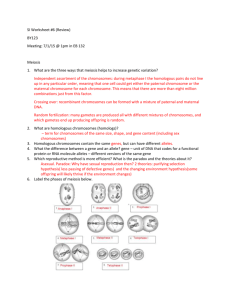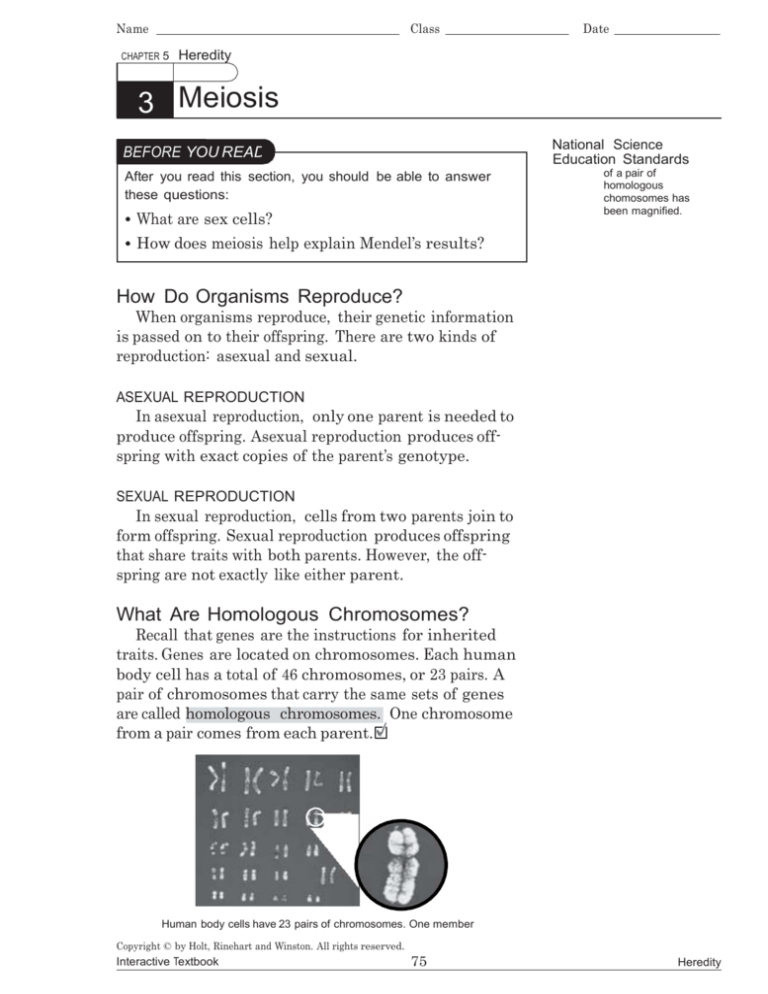
Name
Class
CHAPTER 5
Date
Heredity
SECTION
3 Meiosis
National Science
Education Standards
BEFORE YOU READ
After you read this section, you should be able to answer
these questions:
• What are sex cells?
• How does meiosis help explain Mendel’s results?
of a pair of
homologous
chomosomes has
been magnified.
How Do Organisms Reproduce?
When organisms reproduce, their genetic information
is passed on to their offspring. There are two kinds of
reproduction: asexual and sexual.
ASEXUAL REPRODUCTION
In asexual reproduction, only one parent is needed to
produce offspring. Asexual reproduction produces offspring with exact copies of the parent’s genotype.
SEXUAL REPRODUCTION
In sexual reproduction, cells from two parents join to
form offspring. Sexual reproduction produces offspring
that share traits with both parents. However, the offspring are not exactly like either parent.
What Are Homologous Chromosomes?
Recall that genes are the instructions for inherited
traits. Genes are located on chromosomes. Each human
body cell has a total of 46 chromosomes, or 23 pairs. A
pair of chromosomes that carry the same sets of genes
are called homologous chromosomes. One chromosome
from a pair comes from each parent.
Human body cells have 23 pairs of chromosomes. One member
Copyright © by Holt, Rinehart and Winston. All rights reserved.
Interactive Textbook
75
Heredity
Name
Class
Date
LS 1c, 1d, 2a, 2b, 2c, 2d
STUDY TIP
Summarize Make flashcards that show the steps of meio- sis. On the
front of the cards, write the steps of meiosis.
On the back of the cards, write what happens at each step. Practice
arranging the steps in the correct order.
READING CHECK
1. Define What are homologous chromosomes?
TAKE A LOOK
2. Identify How many total
chromosomes are in each human body cell?
Copyright © by Holt, Rinehart and Winston. All rights reserved.
Interactive Textbook
76
Heredity
Name
SECTION 3
Class
Date
Meiosis continued
!
'ENESCANBE
DIFFERENTALLELES.
Homologous chromosomes
carry the same genes.
'ENE
A
"
"
#
#
$
D
E
E
&
&
'
'
H
(
'ENESCANBETHESAME
VERSION,ORALLELE.
(OMOLOGOUSCHROMOSOMES
What Are Sex Cells?
READING CHECK
3. Explain How are sex cells
different from ordinary body
cells?
STANDARDS CHECK
LS 2b In many species, including
humans, females produce eggs
and males produce sperm...An
egg and sperm unite to begin
development of a new individual.
The individual receives genetic
information from its mother
(via the egg) and its father (via
the sperm). Sexually produced
offspring never are identical to
either of their parents.
4. Define What is the
function of meiosis?
In sexual reproduction, cells from two parents join to
make offspring. However, only certain cells can join.
Cells that can join to make offspring are called sex cells.
An egg is a female sex cell. A sperm is a male sex cell.
Unlike ordinary body cells, sex cells do not have homologous chromosomes.
Imagine a pair of shoes. Each shoe is like a chromosome and the pair represents a homologous pair of
chromosomes. Recall that your body cells have a total of
23 pairs of “shoes,” or homologous chromosomes. Each
sex cell, however, has only one of the chromosomes from
each homologous pair. Sex cells have only one “shoe”
from each pair. How do sex cells end up with only one
chromosome from each pair?
How Are Sex Cells Made?
Sex cells are made during meiosis. Meiosis is a copying process that produces cells with half the usual number of chromosomes. Meiosis keeps the total number of
chromosomes the same from one generation to the next.
In meiosis, each sex cell that is made gets only one
chromosome from each homologous pair. For example, a
human egg cell has 23 chromosomes and a sperm cell has
23 chromosomes. When these sex cells later join together
during reproduction, they form pairs. The new cell has
46 chromosomes, or 23 pairs. The figure on the next page
describes the steps of meiosis. To make the steps easy to
Copyright © by Holt, Rinehart and Winston. All rights reserved.
Interactive Textbook
77
Heredity
Name
see,
only
chromosomes
shown.
Class
Date
four
are
Copyright © by Holt, Rinehart and Winston. All rights reserved.
Interactive Textbook
78
Heredity
Name
SECTION 3
Class
Date
Meiosis continued
Steps of Meiosis
First cell division
Critical Thinking
1 The chromosomes are copied
before meiosis begins. The
identical copies, or chromatids,
are joined together.
3 The chromosomes separate
from their homologous partners.
Then they move to the opposite
ends of the cell.
2 The nuclear membrane disappears.
5. Predict What would happen if meiosis did not occur?
Pairs of homologous chromosomes
line up at the equator of the cell.
4 The nuclear membrane re-forms,
and the cell divides. The paired
chromatids are still joined.
Second cell division
5 Each cell contains one member
re-form, and the cells divide.
of the homologous chromosome
pair. The chromosomes are not
copied again between the two
cell divisions.
6 The nuclear membrane
disappears.
The chromosomes line up
along
the equator of each cell.
7 The chromatids pull apart and
move to opposite ends of the
cell. The nuclear membranes
8 Four new cells have formed from
Copyright © by Holt, Rinehart and Winston. All rights reserved.
Interactive Textbook
79
Heredity
Name
Class
Date
the original cell. Each new cell has
half the number of chromosomes as
the original cell.
TAKE A LOOK
6. Identify How many times
does the cell nucleus divide
during meiosis?
7. Identify At the end of
meiosis, how many sex cells
have been produced from one
cell?
Copyright © by Holt, Rinehart and Winston. All rights reserved.
Interactive Textbook
80
Heredity
Name
SECTION 3
Class
Date
Meiosis continued
How Does Meiosis Explain Mendel’s Results?
Critical Thinking
8. Identify Relationships
How did Sutton’s work build
on Mendel’s work?
Mendel knew that eggs and sperm give the same amount
of information to offspring. However, he did not know how
traits were actually carried in the cell. Many years later, a
scientist named Walter Sutton was studying grasshopper
sperm cells. He knew about Mendel’s work. When he saw
chromosomes separating during meiosis, he made an important conclusion: genes are located on chromosomes.
The figure below shows what happens to chromosomes
during meiosis and fertilization in pea plants. The cross
shown is between two true-breeding plants. One produces
round seeds and the other produces wrinkled seeds.
Meiosis and Dominance
Male Parent In the plant cell nucleus
below, each homologous chromosome
has an allele for seed shape. Each
allele carries the same instructions: to
make wrinkled seeds.
Wrinkled-seed
alleles (rr)
Female Parent In the plant cell
nucleus below, each homologous
chromosome has an allele for seed
shape. Each allele carries the same
instructions: to make round seeds.
Round-seed
alleles (RR)
Meiosis
Meiosis
Sperm cell nucleus
Wrinkled-seed
allele (r)
TAKE A LOOK
9. Explain In this figure,
how many genotypes are
possible for the offspring?
Explain your answer.
Egg cell nucleus
Fertilization
Round-seed
allele (R)
Wrinkled-seed allele (r)
Round-seed allele (R)
First generation
(Rr)
e
g
g
a After meiosis, each sperm
cell has a recessive allele
for wrinkled seeds. Each
Copyright © by Holt, Rinehart and Winston. All rights reserved.
Interactive Textbook
81
Heredity
Name
Class
cell has a dominant allele
for round seeds.
Date
b Fertilization of any egg by
any sperm gives the same
genotype (Rr) and the same
phenotype (round). This
result is exactly what
Mendel found in his studies.
Copyright © by Holt, Rinehart and Winston. All rights reserved.
Interactive Textbook
82
Heredity
Name
Class
SECTION 3
Date
Meiosis continued
What Are Sex Chromosomes?
Information contained on chromosomes determines
many of our traits. Sex chromosomes carry genes that
determine sex. In humans, females have two X chromosomes. Human males have one X chromosome and one
Y chromosome.
During meiosis, one of each of the chromosome pairs
ends up in a sex cell. Females have two X chromosomes
in each body cell. When meiosis produces egg cells, each
READING CHECK
10. Identify What combination of sex chromosomes
makes a human male?
egg gets one X chromosome. Males have both an X chromosome and a Y chromosome in each body cell. Meiosis
produces sperm with either an X or a Y chromosome.
An egg fertilized by a sperm with an X chromosome
will produce a female. If the sperm contains a Y chromosome, the offspring will be male.
disorders. Why is this?
Egg and sperm join to form either the XX or XY combination.
SEX-LINKED DISORDERS
Hemophilia is a disorder that prevents blood from
clotting. People with hemophilia bleed for a long time
after small cuts. This disorder can be fatal. Hemophilia
is an example of a sex-linked disorder. The genes for
sex-linked disorders are carried on the X chromosome.
Colorblindness is another example of a sex-linked disorder. Men are more likely than women to have sex-linked
Copyright © by Holt, Rinehart and Winston. All rights reserved.
Interactive Textbook
83
Heredity
Name
Class
Date
TAKE A LOOK
11. Identify Circle the
offspring in the figure that will be female.
READING CHECK
12. Define What is a sex-linked disorder?
Copyright © by Holt, Rinehart and Winston. All rights reserved.
Interactive Textbook
84
Heredity
Name
SECTION 3
Class
Date
Meiosis continued
This stoplight in Canada was made to help the colorblind see signals easily.
TAKE A LOOK
13. Complete A particular
sex-linked disorder is
recessive. Fill in the Punnett
Square to show how the
disorder is passed from a
carrier to its offspring. The
chromosome carrying the trait
for the disorder is underlined.
14. Identify Which individual
will have the disorder?
The Y chromosome does not carry all of the genes that
an X chromosome does. Females have two X chromosomes, so they carry two copies of each gene found on
the X chromosome. This makes a backup gene available
if one becomes damaged. Males have only one copy of
each gene on their one X chromosome. If a male gets an
allele for a sex-linked disorder, he will have the disorder,
even if the allele is recessive.
X
Y
X
X
GENETIC COUNSELING AND PEDIGREES
Genetic disorders can be traced through a family tree.
If people are worried that they might pass a disease to
their children, they may consult a genetic counselor.
These counselors often use a diagram called a pedigree.
A pedigree is a tool for tracing a trait through generations
of a family. By making a pedigree, a counselor can often predict whether a person is a carrier of a hereditary disease.
The pedigree on the next page traces a disease called
cystic fibrosis. Cystic fibrosis causes serious lung problems. People with this disease have inherited two recessive alleles. Both parents need to be carriers of the gene
for the disease to show up in their children.
Copyright © by Holt, Rinehart and Winston. All rights reserved.
Interactive Textbook
85
Heredity
Name
Class
Date
Meiosis continued
SECTION 3
Pedigree for a Recessive Disease
&EMALES
-ALES
6ERTICALLINESCONNECTCHILDRENTOTHEIRPARENTS.
OR
!SOLIDSQUAREORCIRCLESHOWSTHATTHEPERSON
HASACERTAINTRAIT.
OR
!HALF-FILLEDSQUAREORCIRCLESHOWSTHATTHE
PERSONISACARRIERFORTHETRAIT.
Generation
I
1
2
3
4
II
1
2
5
6
TAKE A LOOK
15. Identify Circle all of the
individuals in the pedigree
III
1
2
3
4
IV
1
2
3
who have the disorder. Draw a
line under the individuals that
carry the trait, but do not
have the disorder.
You could draw a pedigree to trace almost any trait
through a group of people who are biologically related.
For example, a pedigree can show how you inherited
your hair color. Many different pedigrees could be drawn
for related individuals.
What Is Selective Breeding?
For thousands of years, humans have bred plants
and animals to produce individuals with traits that they
liked. This is known as selective breeding. Breeders
may choose a plant or animal with traits they would like
to see in the offspring. They breed that individual with
another that also has those traits. For example, farmers
might breed fruit trees that bear larger fruits.
You may see example of selective breeding every day.
Different breeds of dogs, such as chihuahuas and German
sheperds, were produced by selective breeding. Many
flowers, such as roses, have been bred to produce large
flowers. Wild roses are usually much smaller than roses
you would buy at a flower store or plant nursery.
Say It
Discuss In a small group,
come up with other examples
of organisms that humans
have changed through
selective breeding. What traits
do you think people wanted
the organism to have? How is
this trait helpful to humans?
Copyright © by Holt, Rinehart and Winston. All rights reserved.
Interactive Textbook
86
Heredity
Name
Class
Section 3 Review
Date
NSES
LS 1c, 1d, 2a, 2b, 2c, 2d
SECTION VOCABULARY
homologous chromosomes chromosomes that
have the same sequence of genes and the
same structure
meiosis a process in cell division during which
the number of chromosomes decreases to half
the original number by two divisions of the
nucleus, which results in the production of sex
cells (gametes or spores)
pedigree a diagram that shows the occurrence of a
genetic trait in several generations of a family
sex chromosomes one of the pair of chromosomes
that determine the sex of an individual
1. Identify Relationships Put the following in order from smallest to largest:
chromosome, gene, cell.
2. Explain Does meiosis happen in all cells? Explain your answer.
The pedigree below shows a recessive trait that causes a disorder. Use the
pedigree to answer the questions that follow.
3. Identify Circle all individuals on the pedigree that are heterozygous for the trait.
Are these individuals male or female?
4. Identify Put a square around all individuals that have the disorder. Are these
individuals male or female?
5. Interpret Is the trait sex-linked? Explain your answer.
Copyright © by Holt, Rinehart and Winston. All rights reserved.
Interactive Textbook
87
Heredity
Name
Class
Date
Copyright © by Holt, Rinehart and Winston. All rights reserved.
Interactive Textbook
88
Heredity



